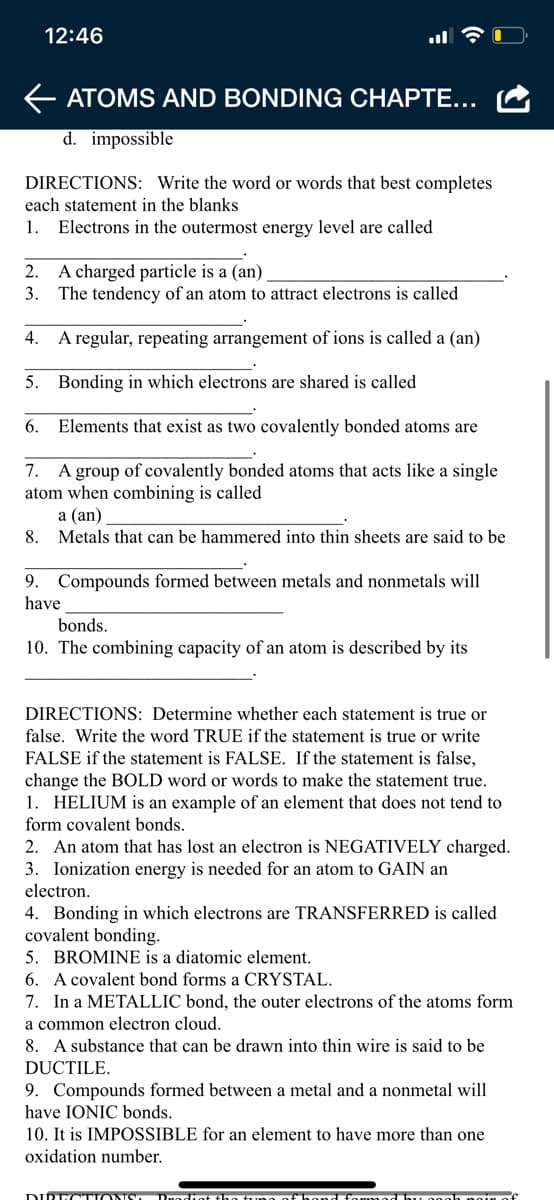Chemistry for Engineering Students
4th Edition
ISBN:9781337398909
Author:Lawrence S. Brown, Tom Holme
Publisher:Lawrence S. Brown, Tom Holme
Chapter7: Chemical Bonding And Molecular Structure
Section: Chapter Questions
Problem 7.30PAE: 7.30 The bond in HF is said to be polar, with the hydrogen carrying a partial positive charge. For...
Related questions
Question
answer 1 through 10 in the blank spaces

Transcribed Image Text:12:46
E ATOMS AND BONDING CHAPTE...
d. impossible
DIRECTIONS: Write the word or words that best completes
each statement in the blanks
1.
Electrons in the outermost energy level are called
2. A charged particle is a (an)
The tendency of an atom to attract electrons is called
3.
4. A regular, repeating arrangement of ions is called a (an)
5.
Bonding in which electrons are shared is called
6.
Elements that exist as two covalently bonded atoms are
7. A group of covalently bonded atoms that acts like a single
atom when combining is called
а (an)
8.
Metals that can be hammered into thin sheets are said to be
9. Compounds formed between metals and nonmetals will
have
bonds.
10. The combining capacity of an atom is described by its
DIRECTIONS: Determine whether each statement is true or
false. Write the word TRUE if the statement is true or write
FALSE if the statement is FALSE. If the statement is false,
change the BOLD word or words to make the statement true.
1. HELIUM is an example of an element that does not tend to
form covalent bonds.
2. An atom that has lost an electron is NEGATIVELY charged.
3. Ionization energy is needed for an atom to GAIN an
electron.
4. Bonding in which electrons are TRANSFERRED is called
covalent bonding.
5. BROMINE is a diatomic element.
6. A covalent bond forms a CRYSTAL.
7. In a METALLIC bond, the outer electrons of the atoms form
a common electron cloud.
8. A substance that can be drawn into thin wire is said to be
DUCTILE.
9. Compounds formed between a metal and a nonmetal will
have IONIC bonds.
10. It is IMPOSSIBLE for an element to have more than one
oxidation number.
DIRE CTIO TS. Dmodiet ihe trum e ofho nd fer med b L OGah noIN Ofe
Expert Solution
This question has been solved!
Explore an expertly crafted, step-by-step solution for a thorough understanding of key concepts.
Step by step
Solved in 2 steps

Knowledge Booster
Learn more about
Need a deep-dive on the concept behind this application? Look no further. Learn more about this topic, chemistry and related others by exploring similar questions and additional content below.Recommended textbooks for you

Chemistry for Engineering Students
Chemistry
ISBN:
9781337398909
Author:
Lawrence S. Brown, Tom Holme
Publisher:
Cengage Learning

Principles of Modern Chemistry
Chemistry
ISBN:
9781305079113
Author:
David W. Oxtoby, H. Pat Gillis, Laurie J. Butler
Publisher:
Cengage Learning

Introductory Chemistry: A Foundation
Chemistry
ISBN:
9781337399425
Author:
Steven S. Zumdahl, Donald J. DeCoste
Publisher:
Cengage Learning

Chemistry for Engineering Students
Chemistry
ISBN:
9781337398909
Author:
Lawrence S. Brown, Tom Holme
Publisher:
Cengage Learning

Principles of Modern Chemistry
Chemistry
ISBN:
9781305079113
Author:
David W. Oxtoby, H. Pat Gillis, Laurie J. Butler
Publisher:
Cengage Learning

Introductory Chemistry: A Foundation
Chemistry
ISBN:
9781337399425
Author:
Steven S. Zumdahl, Donald J. DeCoste
Publisher:
Cengage Learning

General Chemistry - Standalone book (MindTap Cour…
Chemistry
ISBN:
9781305580343
Author:
Steven D. Gammon, Ebbing, Darrell Ebbing, Steven D., Darrell; Gammon, Darrell Ebbing; Steven D. Gammon, Darrell D.; Gammon, Ebbing; Steven D. Gammon; Darrell
Publisher:
Cengage Learning

Introductory Chemistry: An Active Learning Approa…
Chemistry
ISBN:
9781305079250
Author:
Mark S. Cracolice, Ed Peters
Publisher:
Cengage Learning

Chemistry: The Molecular Science
Chemistry
ISBN:
9781285199047
Author:
John W. Moore, Conrad L. Stanitski
Publisher:
Cengage Learning